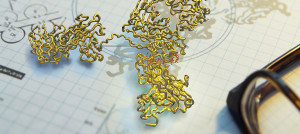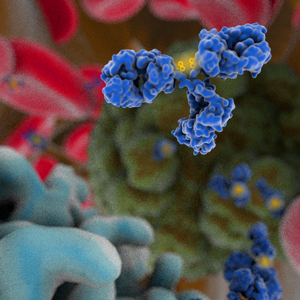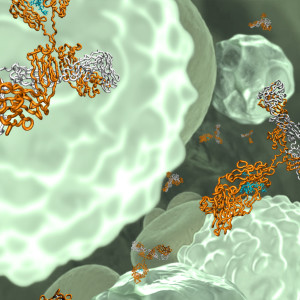The Third AIRR Community Meeting will be held December 3-6 at the NIH Fishers Lane facility. Please visit the Third AIRR Community Meeting page for more information.
Mouse vs Pan
By William R (Bill) Strohl, BiStro Biotech Consulting LLC, 7-25-17
This is the first of several blogs that I will be writing for The Antibody Society on topics in the field of therapeutic antibodies and proteins that I find of interest. The intention of these blogs is to stimulate thought and discussion about various aspects of therapeutic antibodies and related molecules, something that anyone reading on this website ought to appreciate. For my first blog, I thought I would tackle an age-old (at least since the 1990s) discussion point concerning the use of transgenic mice producing human antibodies vs panning human libraries as preferred sources for fully human antibodies. Virtually everyone with whom I have had the opportunity to discuss this topic has an opinion on it, some of which are rather strong. That should make this all the more fun! Moreover, 2017 appears, at least thus far, to be the year of the fully human antibody. Thus far (to 7/23/17), 23 innovative drugs have been approved by the US Food and Drug Administration (FDA), seven of which are monoclonal antibodies. Of those, six are fully human antibodies!
I’ll start out by reminiscing about antibody meetings in the timeframe of around 2000-2001, before any fully human antibodies were approved for marketing and commercial use. In those days, scientists from the big four, i.e., Medarex and Abgenix on the transgenic mouse side, and Cambridge Antibody Technology (CaT) and Morphosys on the human antibody library side, would give talks at meetings, often back to back, on their platforms. Of course, as would be expected, each group would expound on the positives for their particular approach, while finding negatives, or minimally providing neutral comments, for the others. Coffee breaks and lunches at those meetings were typically filled with discussion about which approach, transgenic mouse or human antibody library panning, was better. It was a fun time, watching, listening to, and participating in those discussions. I’m sure that in many venues, vigorous discussions along the line of “Mouse vs Pan” still continue.
I will say up front that I don’t particularly have a favorite, because I see the potential use of both approaches. Anecdotally, over my career I have been involved with many programs that were sourced from Balb/c mice and then humanized, transgenic mice producing human antibodies, and human antibody libraries, and I can’t say categorically that I’ve seen that a trend for “better antibodies” coming from one source or another. It turns out that one of the worst behaved antibodies we made actually came from a Balb/c mouse, and it took intense phage-based engineering to improve the antibody into one that could potentially be developed.
First, though, to the statistics: we all know that the first “fully human” antibody to be approved for commercial use, and the most valuable antibody on the market today, is adalimumab, marketed by Abbvie under the name of Humira®. Approved by the US FDA in December, 2002, Humira® was used to treat nearly a million patients in 2016 and generated over US $16 billion in gross revenues. Adalimumab was sourced from the CaT human antibody library using a technology called guided selection.
With the very recent approval of Janssen R&D’s guselkumab, there are now 75 antibodies and Fc fusion proteins approved by major regulatory agencies, according to my database. Of these, 25 (one-third!) are fully human antibodies, 18 of which were derived from transgenic mice producing human antibodies and seven derived from human antibody libraries. Additionally, there are currently 69 antibodies and Fc fusion proteins in Phase III clinical trials, 20 of which are fully human antibodies. Of these 20 late clinical stage human antibody candidates, 10 are from transgenic mice, six were derived from human antibody libraries, and four are sourced directly from human B cells (i.e., the new kid on the block). Combining the approved and Phase III numbers leaves us with 28 approved or late stage human antibodies sourced from transgenic mice, 13 sourced from human antibody libraries, and another four from human B cells.
From the data above, it is clear that transgenic mice have played a much larger role to date than antibody libraries in sourcing successful candidates that have either reached approval stage or late stage clinical trials. That may or may not tell the whole story, however, as target selection, financing, collaborations, and clinical expertise of the four innovative companies mentioned above, dating back to the pre-2005 timeframe also would have a huge impact on those programs that ultimately were successful and represented by these data. I do believe, however, that the overall numbers don’t lie, and that for many targets, including soluble cytokines or other serum proteins and single pass receptors with prominent exodomains, the combination of which make up the vast majority of antibody targets, immunization of a transgenic animal should lead rapidly to high quality, high affinity antibodies. When it comes to isolating epitopes, certain infectious disease targets, and multi-pass membrane proteins, however, often times human antibody library display approaches may have an edge to obtain the right antibody to develop.
Historically, there has been a preconception, largely supported by various data, that antibodies derived from animals or mammalian cells were generally “better behaved” than antibodies derived from human antibody libraries (Jain et al., 2017). Many papers have been written supporting various aspects of this argument, including the case against hydrophobic patches found in library-based antibodies, the case for phage-based sequence bias, the lack of mammalian cell “editing”, the need for in vitro affinity maturation, and so forth. Some of these arguments may apply to some library-sourced antibodies, but likely not to all of them. Many human antibody library antibodies in fact are derived from human antibody genes using PCR-based approaches. Depending on the maturation level of the recovered variable sequences, one would expect that many of these structures might be more “animal like”, even if they have not gone through substantial in vivo editing. Moreover, more and more library-based approaches are using eukaryotic cells (e.g., yeast, mammalian cells) for expression and display of their antibodies, which should improve the selection for antibodies with improved expression, folding, and solubility characteristics.
There are now more than a dozen transgenic animal platforms available today, ranging from the original Medarex HuMab mouse and the Abgenix Xenomouse, to transgenic rats, rabbits, chickens, and even cows producing human antibodies, so there is no shortage of potential transgenic animal platforms from which to derive human antibodies (Strohl, 2017). Moreover, most companies using these approaches have moved away from low yield hybridomas to high yield and throughput B cell cloning approaches, substantially increasing the ability to obtain high quality clones from animals.
Likewise, for displayed antibodies, the field has progressed significantly from phage displayed scFv or Fab human antibody libraries from CaT and Morphosys, respectively, to libraries generated and panned in yeast, mammalian cells, and most recently, in recombinant mammalian cells in which the antibodies are matured “in cell”. Thus, the range of display options, combined with FACS sorting and analysis, next generation sequencing, and tagging technologies, have significantly increased the ability to obtain large numbers of high quality antibodies from human antibody libraries.
The critical quality attributes of a human antibody panel are: (i) the ability to bind and neutralize key “functional” epitopes; (ii) high affinity and selectivity; (iii) proper biophysical properties (e.g., “well-behaved”, soluble, not aggregation-prone, biochemical stability); (iv) excellent expression as full-length antibodies in manufacturing cell lines; and (v) lack of immunogenicity when dosed in humans. While virtually any of the approaches discussed above can ultimately end up with excellent attributes in each category, it is likely that, for most targets, antibodies sourced from transgenic animals will be more likely to achieve all the attributes more easily and quickly than those sourced from traditional human antibody libraries. This may evolve, however, as improved cell-based maturation and panning approaches, such the HuTARG™ technology developed by Innovative Targeting Solutions in Vancouver, which couples mammalian display with cell-based V(D)J recombination and FACS sorting, may revolutionize how fully human antibody variable sequences are sourced in the future.
References:
Strohl WR. 2017. Chapter 5. Human antibody discovery platforms, pp. 115-160. Protein Therapeutics, 2 Volume Set. T. Vaughan, J. Osbourn, B. Jallal, R. Mannhold, G. Folkers, H. Buschmann, eds. Wiley. ISBN: 978-3-527-34086-6.
Jain T, Sun T, Durand S, Hall A, Houston NR, Nett JH, Sharkley B, Bobrowitz B, Caffry I, et al. 2017. Biophysical properties of the clinical-stage antibody landscape. Proc. Nat’l. Acad. Sci. USA 114:944-949.
Happy antibody hunting…
Bill Strohl, www.bistrobiotech.com
First approval for guselkumab
 On July 13, 2017, the Food and Drug Administration (FDA) approved the biologics license application for guselkumab (TREMFYA). The product, a human IgG1 monoclonal antibody targeting interleukin-23, is indicated for the treatment of patients with moderate-to-severe plaque psoriasis who are candidates for systemic therapy or phototherapy. Approval was based on results from a clinical development program that included more than 2,000 patients in the Phase 3 VOYAGE 1, VOYAGE 2 and NAVIGATE studies. Guselkumab was generated using MorphoSys’ Human Combinatorial Antibody Library technology.
On July 13, 2017, the Food and Drug Administration (FDA) approved the biologics license application for guselkumab (TREMFYA). The product, a human IgG1 monoclonal antibody targeting interleukin-23, is indicated for the treatment of patients with moderate-to-severe plaque psoriasis who are candidates for systemic therapy or phototherapy. Approval was based on results from a clinical development program that included more than 2,000 patients in the Phase 3 VOYAGE 1, VOYAGE 2 and NAVIGATE studies. Guselkumab was generated using MorphoSys’ Human Combinatorial Antibody Library technology.
As of July 13, guselkumab is the eighth antibody therapeutic to be granted a first marketing approval in any country in 2017, following the approvals of brodalumab, avelumab, ocrelizumab, dupilumab, durvalumab, sarilumab and inotuzumab ozogamicin. The Antibody Society maintains a comprehensive table of approved antibody therapeutics and those in regulatory review in the EU or US. As of July 13, 2017, marketing applications for a total of nine antibody therapeutics that have not been approved in any country are undergoing review in the EU or US. In addition, a marketing application for the antibody-drug conjugate gemtuzumab ozogamicin, which was approved in 2000 by the US FDA and subsequently withdrawn from the US market, is undergoing review in the EU and US.
Please log in to access the table, located in the Members Only section.
Not a member? Please join!
Membership is free for students and employees of the Society’s corporate sponsors.
First approval for inotuzumab ozogamicin in the European Union
 The European Commission has granted a marketing approval for the antibody-drug conjugate (ADC) inotuzumab ozogamicin (BESPONSA) as monotherapy for the treatment of adults with relapsed or refractory CD22-positive B-cell precursor acute lymphoblastic leukemia (ALL). Inotuzumab ozogamicin is a CD22-targeting humanized IgG4 antibody conjugated to the drug calicheamicin via an acetyl butyrate linker. The approval of BESPONSA was supported by results from the Phase 3 INO-VATE ALL trial (ClinicalTrials.gov number NCT01564784), which compared the effects of either inotuzumab ozogamicin or standard intensive chemotherapy in adults with relapsed or refractory ALL Results of this study were published in The New England Journal of Medicine in 2016. A biologics license application for inotuzumab ozogamicin for the treatment of adult patients with relapsed or refractory B-cell precursor ALL is undergoing a priority review by the US Food and Drug Administration (FDA); the goal date for their decision is in August 2017.
The European Commission has granted a marketing approval for the antibody-drug conjugate (ADC) inotuzumab ozogamicin (BESPONSA) as monotherapy for the treatment of adults with relapsed or refractory CD22-positive B-cell precursor acute lymphoblastic leukemia (ALL). Inotuzumab ozogamicin is a CD22-targeting humanized IgG4 antibody conjugated to the drug calicheamicin via an acetyl butyrate linker. The approval of BESPONSA was supported by results from the Phase 3 INO-VATE ALL trial (ClinicalTrials.gov number NCT01564784), which compared the effects of either inotuzumab ozogamicin or standard intensive chemotherapy in adults with relapsed or refractory ALL Results of this study were published in The New England Journal of Medicine in 2016. A biologics license application for inotuzumab ozogamicin for the treatment of adult patients with relapsed or refractory B-cell precursor ALL is undergoing a priority review by the US Food and Drug Administration (FDA); the goal date for their decision is in August 2017.
As of July 1, inotuzumab ozogamicin is the seventh antibody therapeutic to be granted a first marketing approval in any country in 2017, following the approvals of brodalumab, avelumab, ocrelizumab, dupilumab, durvalumab, and sarilumab. The Antibody Society maintains a comprehensive table of approved antibody therapeutics and those in regulatory review in the EU or US. As of July 1, 2017, marketing applications for a total of 10 antibody therapeutics that have not been approved in any country are undergoing review in the EU or US. In addition, a marketing application for the ADC gemtuzumab ozogamicin, which was approved in 2000 by the US FDA and subsequently withdrawn from the US market, is undergoing review in the EU and US.
Please log in to access the table, located in the Members Only section.
Membership is free for students and employees of the Society’s corporate sponsors.
Importance of isoelectric point (pI) of antibodies
 One important characteristic of monoclonal antibodies (mAbs) is their isoelectric point (pI), which essentially is the pH at which the antibody has no net electrical charge, and its value depends on the charged amino acids the antibody contains. If the pH of the surrounding environment is below the antibody’s pI, then the molecule carries a net positive charge, whereas the antibody will carry a net negative charge when the pH is above the pI.
One important characteristic of monoclonal antibodies (mAbs) is their isoelectric point (pI), which essentially is the pH at which the antibody has no net electrical charge, and its value depends on the charged amino acids the antibody contains. If the pH of the surrounding environment is below the antibody’s pI, then the molecule carries a net positive charge, whereas the antibody will carry a net negative charge when the pH is above the pI.
When assessing pharmacokinetic (PK) properties of therapeutic antibodies not only the target-mediated drug disposition (TMDD) but also non-target-related mechanisms influence overall PK behavior and pI can be an important factor of the latter. Since the surface of most cells is negatively charged, antibodies need to be positively charged for efficient fluid-phase endocytosis (pinocytosis), therefore the environmental pH needs to be below the pI of the antibody. Therapeutic antibodies with pI values in the range of 8-9 are taken up adequately after administration since the physiological pH is 7.4, however, in some cases antibodies have a pI outside of this range or have been manipulated to achieve increased or decreased pI values (cationization or anionization, respectively). It is generally observed that increases in net positive charge of antibodies result in increased blood clearance and increased tissue retention with shorter half-life, whereas antibodies with lower pI generally have decreased tissue uptake and longer half-life (1-3), although observations can be conflicting regarding correlation between mAb clearance and pI (4). Even subtle manipulation such as molecular surface remodeling to disrupt positive patch regions can influence PK properties (5). In summary, pI of mAbs is known to have a substantial effect on PK behavior independent of recycling mediated by the neonatal Fc receptor, FcRn. Small changes of pI during the routine manufacturing of mAb charge variants, however, are not expected to result in dramatic changes and may not require extensive analyses (6). In any case, it is encouraged that pI values are reported in studies as an important factor influencing antibody behavior. Furthermore, since selecting the best candidates during early preclinical phases of product development can substantially decrease time and cost of development, it is of great importance to consider de-risk strategies and tools during drug discovery and development, including antibody variable region charge and antibody pI analyses (7-9). A new analytical platform has been recently described and validated on seven mAbs to rapidly assess and rank mAb charge variants during early stage development, which can be a useful screening technique during early stage development (10).
References:
1 Boswell et al, Bioconjug Chem. 2010 Dec 15;21(12):2153-63.
2 Igawa et al, Protein Eng Des Sel. 2010 May;23(5):385-92.
3, Li et al, MAbs. 2014;6(5):1255-64.
4, Hötzel et al, MAbs. 2012 Nov-Dec;4(6):753-60.
5, Datta-Mannan et al, MAbs. 2015;7(3):483-93.
6, Khawli et al, mAbs, 2010;(2)6:613-624.
7, Bumbaca Yadav et al, J Biol Chem. 2015 Dec 11;290(50):29732-41.
8, Dostalek et al, MAbs. 2017 May 2:1-11.
9, Jarasch et al, J Pharm Sci. 2015 Jun;104(6):1885-98.
10, Wagner-Rousset, J Chromatogr A. 2017 May 19;1498:147-154.


